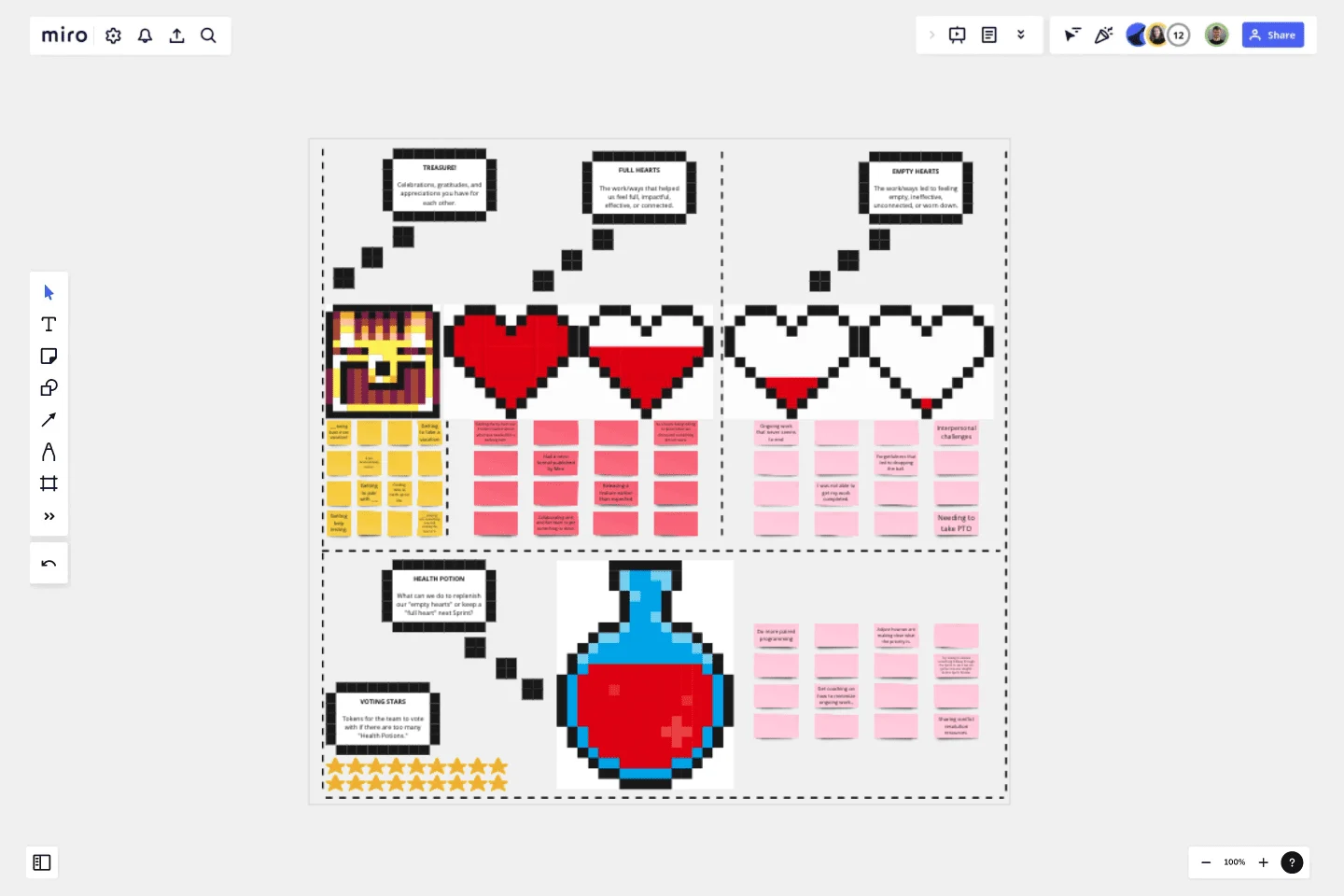8 Bit Hearts - A Retrospective
This 60-90 minute retrospective is inspired by retro games that used hearts to show how damaged or undamaged a player is.
In honor of 8-bit designs, all graphics used in this retro were made by using, coloring, and grouping square shapes directly in Miro.
The purpose of this retrospective is to identify ways this past Sprint our "hearts" were full or empty, impacting our ability to feel impactful in our roles, with our work, or with our interpersonal interactions; SO THAT we can understand how to promote "full hearts" next Sprint. By the end of the activity, your group should have at least one thing they can do as individuals or as a team to replenish their "hearts" for the next Sprint OR keep their hearts from depleting.
How to use this template
The template already contains all the elements you need to work with a team of up to 9 people. The retrospective will play out in four segments:
Intro: Review the purpose and outcome as a group. Describe each of the groupings participants will contribute to in step 2 (Treasure, Full Hearts, Empty Hearts).
Gather Data: Ask participants to contribute to the board.
Gather Insights: Facilitate an open conversation about the data.
Decide: Brainstorm what could be done next Sprint to replenish empty hearts or keep full hearts.
Tips
Enjoy the theme and use it to lighten the mood.
If you want to customize the color of images, you can use the grouped shapes in the TEMPLATE frame.
If you want to have just images and reduce load time, use the JPEG version of the images in the EXAMPLE frame.
This template was created by Cody Wanberg.
Get started with this template right now.
Quick Retrospective by Online Department
Works best for:
Retrospectives, Agile Methodology
The Quick Retrospective template offers a concise and efficient framework for teams to reflect on recent iterations or projects. It provides elements for sharing successes, challenges, and action items in a streamlined format. This template enables teams to conduct retrospectives quickly and effectively, even with limited time. By promoting efficiency and focus, the Quick Retrospective empowers teams to drive meaningful improvements and maintain momentum in their work effectively.
Design Sprint Retrogram
Works best for:
Agile, Retrospective
The Design Sprint Retrogram template facilitates retrospective sessions for Design Sprint teams to reflect on their experiences and identify improvement opportunities. It provides a structured framework for reviewing sprint outcomes, discussing what worked well, what didn't, and generating actionable insights. This template fosters a culture of continuous learning and refinement, empowering teams to enhance their sprint process and deliver better outcomes in subsequent sprints.
Reflection Island: End of Year Team Retro
Works best for:
Retrospectives, Agile Methodology, Meetings
The Reflection Island: End of Year Team Retro template offers a creative and themed approach to retrospectives, perfect for wrapping up the year. It provides elements for reflecting on achievements, challenges, and goals using a tropical island theme. This template enables teams to celebrate successes, learn from setbacks, and set intentions for the upcoming year in a relaxed and enjoyable atmosphere. By promoting reflection and celebration, the Reflection Island: End of Year Team Retro empowers teams to strengthen bonds, boost morale, and start the new year with renewed energy and focus effectively.
Taco Tuesday Retrospective
Works best for:
Agile Methodology, Retrospectives, Meetings
The Taco Tuesday Retrospective template offers a fun and informal approach to retrospectives, perfect for fostering team camaraderie. It provides elements for reflecting on past iterations over a casual taco-themed gathering. This template enables teams to relax, share insights, and brainstorm ideas in a laid-back atmosphere. By promoting social interaction and creativity, the Taco Tuesday Retrospective empowers teams to strengthen relationships, boost morale, and drive continuous improvement effectively.
Retrospective - Christmas Edition
Works best for:
Agile Methodology, Retrospectives, Meetings
The Retrospective Christmas Edition template offers a festive and themed approach to retrospectives, perfect for the holiday season. It provides elements for reflecting on the year's achievements, sharing gratitude, and setting intentions for the upcoming year. This template enables teams to celebrate successes, foster camaraderie, and align on goals amidst the holiday spirit. By promoting a joyful and reflective atmosphere, the Retrospective - Christmas Edition empowers teams to strengthen relationships, recharge spirits, and start the new year with renewed energy and focus effectively.
The 4-Step Retrospective
Works best for:
Retrospectives, Agile Methodology, Meetings
The 4-Step Retrospective template offers a simple yet effective framework for conducting retrospectives. It provides steps for reflecting on what went well, what didn't go well, what could be improved, and action planning. This template enables teams to systematically review past iterations, identify areas for growth, and implement actionable improvements. By promoting a structured approach to reflection and improvement, the 4-Step Retrospective empowers teams to drive continuous learning and enhancement effectively.
